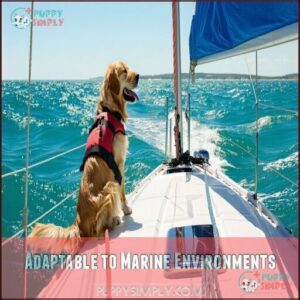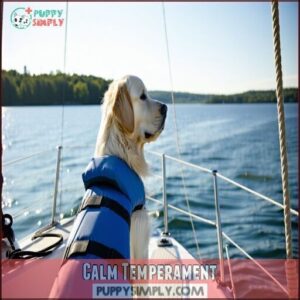This site is supported by our readers. We may earn a commission, at no cost to you, if you purchase through links.
 You’ll find that the best boat dogs include water-loving breeds like Labrador Retrievers, Portuguese Water Dogs, and Newfoundlands.
You’ll find that the best boat dogs include water-loving breeds like Labrador Retrievers, Portuguese Water Dogs, and Newfoundlands.
These nautical companions have natural adaptations—waterproof coats and sometimes webbed paws—making them perfect shipmates. Labs are particularly versatile, equally happy swimming alongside your kayak or lounging on your sailboat’s deck.
Consider your vessel’s size too; a Newfoundland might overwhelm a small craft, while a Nova Scotia Duck Tolling Retriever fits perfectly. Breeds with shorter coats will make clean-up easier when they inevitably shake off after a dip.
Proper training guarantees your four-legged first mate knows the ropes of marine safety.
Table Of Contents
Key Takeaways
- You’ll find the most suitable boat dogs in water-loving breeds like Labrador Retrievers, Portuguese Water Dogs, and Newfoundlands, which have natural adaptations such as waterproof coats and webbed feet that make them perfect maritime companions.
- Consider your vessel’s size when choosing a boat dog—larger breeds like Newfoundlands might overwhelm smaller crafts, while compact breeds such as Jack Russell Terriers and Schipperkes navigate decks with impressive agility while requiring less space.
- Look for dogs with calm temperaments and high trainability, as they’ll handle unexpected waves and changing conditions better, making Retrievers and Portuguese Water Dogs excellent choices that maintain their composure during choppy waters.
- Don’t forget safety—even natural swimmers benefit from proper training and dog life vests, which transform your canine from passenger to capable crew member and ensure their protection during your nautical adventures.
Top Boating Breeds
When selecting a canine companion for life on the water, certain breeds stand out as natural seafarers due to their inherent abilities and temperaments.
Labrador Retrievers reign supreme in breed popularity, boasting webbed feet and water-resistant coats that make them born sailors. They’re like fish in dog form!
Portuguese Water Dogs offer non-shedding benefits with their waterproof fur—perfect for keeping your vessel tidy during extended journeys.
Size matters when choosing your nautical buddy: compact Schipperkes navigate decks with impressive agility, while gentle giants like Newfoundlands provide natural rescue abilities for family outings.
Consider energy levels too—spirited Jack Russell Terriers pack enthusiasm into small packages, ideal for limited space. Many boat owners also consider low-shedding breeds to minimize cleanup.
Don’t forget shedding factors and breed lifespan when selecting your perfect first mate. Most importantly, regardless of breed, always prioritize dog boat safety with a proper dog life vest!
Water-Loving Traits
You’ll notice certain physical characteristics in boat-loving breeds that make them naturally suited for aquatic adventures.
Their specialized traits, such as webbed feet for powerful swimming and water-resistant coats that dry quickly, are evolutionary adaptations that transform an ordinary canine companion into the perfect shipmate.
Webbed Feet
Among the most remarkable physical traits of top boat dogs, webbed feet stand out as a natural evolutionary advantage that transforms ordinary canines into aquatic masters.
These specialized paws create excellent swimming efficiency, with breed variations showing different degrees of webbing. You’ll notice this amphibious lifestyle adaptation in Labrador Retrievers, Portuguese Water Dogs, and Newfoundlands—all breeds with superior dog swimming abilities.
To keep your dog’s webbed paws in top condition:
- Rinse with fresh water after swimming to remove salt and debris
- Inspect between toes weekly for cuts or foreign objects
- Apply pet-safe moisturizer during dry seasons
- Trim excess fur between pads for better traction
Paw anatomy differs substantially between breeds, but this natural "flipper" design helps your furry first mate navigate slippery decks with confidence while boosting their dog adaptability to water environments. Consider using a quality paw balm to prevent cracking and ensure your dog remains a happy swimming companion.
Waterproof Coat
A waterproof coat is your boat dog’s natural lifejacket against the elements.
Nature has designed these specialized coats with oils that repel moisture, keeping your canine companion comfortable during inevitable splashes and swims.
Different breeds showcase varying levels of water resistance, with essential benefits for boat life:
| Breed | Coat Type | Grooming Needs |
|---|---|---|
| Labrador Retriever | Dense, water-resistant double coat | Weekly brushing, minimal bathing |
| Portuguese Water Dog | Non-shedding, waterproof curls | Regular trimming, moderate brushing |
| Irish Water Spaniel | Curly, waterproof coat | Monthly grooming, occasional bathing |
| Chesapeake Bay Retriever | Oily, water-repellent coat | Light brushing, seasonal shedding |
These waterproof coats provide vital insulation in chilly waters while reducing drying time after swims—no more wet dog smell permeating your cabin!
Many owners also opt for a protective dog outwear to further shield their canine companions.
For ideal dog coat maintenance, brush weekly to remove debris without stripping protective oils.
Use gentle, natural shampoos that won’t compromise your dog’s built-in water resistance.
Intelligent Dog Breeds
You’ll find that intelligent boat dogs like Portuguese Water Dogs, Border Collies, and Standard Poodles quickly learn boat-specific commands and solve problems when faced with nautical challenges.
These smart companions won’t just follow your lead on the water—they’ll anticipate needs, adapt to changing conditions, and make boating safer and more enjoyable for everyone aboard, utilizing their ability to solve problems and being intelligent.
Trainability
While water-resistant coats keep dogs dry, their trainability determines how well they’ll adapt to nautical life.
When choosing a boat dog, look for breeds with exceptional command consistency. Border Collies and Poodles can learn new commands in under five repetitions, making dog obedience training efficient and effective.
For successful dog boating training, focus on:
- Basic obedience drills – Sit, stay, and come commands prevent dangerous situations
- Boat etiquette – Teaching boundaries about where they can/can’t go
- Leash proficiency – Essential for marina visits where distractions multiply
- Water commands – Specific instructions for water entry/exit
Professional trainers can help establish these foundations, but daily positive reinforcement is your secret weapon. Labs and Portuguese Water Dogs excel in trainability, combining intelligence with natural water affinity.
Remember, a well-trained dog transforms from passenger to crew member in no time!
Problem-Solving Skills
Beyond trainability, a dog’s problem-solving skills are invaluable when you’re out on the water.
Border Collies demonstrate unmatched canine cognition, learning new commands in fewer than five repetitions and applying that knowledge to unexpected boat challenges.
When facing choppy waters or unfamiliar situations, Poodles excel through their independent thinking.
They won’t just wait for instructions—they’ll assess the situation and act accordingly, making them perfect companions for boating adventures.
Shetland Sheepdogs bring excellent problem-solving capabilities to your vessel, while German Shepherds can quickly discriminate between welcome visitors and potential threats—an important skill in busy marinas.
Jack Russell Terriers combine their protective nature with quick learning abilities, adjusting rapidly to life aboard.
For maximum engagement, introduce puzzle toys during quieter moments on the boat; they’ll strengthen your dog’s boat-specific intelligence while providing entertainment.
The best boat dogs aren’t just followers—they’re clever partners who anticipate needs before you even express them.
Physical Adaptations for Boating
While intelligent breeds excel at learning boat commands, it’s their physical traits that truly make them maritime masters.
Your four-legged sailor comes equipped with remarkable adaptations that transform ordinary dogs into nautical companions. These physical features determine their swimming ability and overall water safety:
- Webbed feet function like built-in flippers, giving breeds like the American Water Spaniel powerful propulsion
- Waterproof coats repel moisture and dry quickly, preventing that wet dog smell from permeating your cabin
- Joint flexibility helps maintain balance on rolling decks when seas get choppy
- Muscle endurance allows for extended swimming sessions without tiring
- Vision acuity helps them spot obstacles in water, enhancing their awareness
Dogs with water-resistant coats like Poodles stay comfortable even after multiple dips. Their natural dog breed adaptations mean less worry for you during aquatic adventures. Jack Russell Terriers might be small, but their sturdy build and high energy make them surprisingly capable seafarers. Some breeds, like Great Danes, may require positive water exposure to become confident swimmers.
Isn’t it amazing how nature designed the perfect boat companions?
Versatile and Compatible Breeds
You’ll find that Labrador Retrievers, Portuguese Water Dogs, Newfoundlands, and Poodles adapt exceptionally well to boating life, combining their natural swimming abilities with friendly temperaments.
These versatile companions won’t just tolerate your nautical adventures—they’ll actively enhance your experience with their water-loving nature and ability to fit seamlessly into your maritime lifestyle, making them perfect for a maritime lifestyle with their natural ability to swim.
Enjoyment of Activities
While some dogs have physical features perfectly suited for water adventures, their enthusiasm for boat-based activities truly makes them exceptional companions.
Your nautical sidekick’s enjoyment transforms routine outings into memorable experiences through various engaging activities:
- Swimming Fun – Watch different breeds showcase unique swimming styles, from Labradors’ powerful strokes to Portuguese Water Dogs’ elegant movements
- Dock Jumping – Many water-loving breeds naturally excel at leaping from boat platforms, creating impressive splashes that match their excitement
- Playing Fetch – Floating toys turn ordinary retrieval into exhilarating boat games that exercise both body and mind
- Canine Exercise – Activities like paddleboarding or kayaking become shared adventures with your four-legged crew member
Remember to outfit your dog with a proper life jacket for safety during these adventures, especially in choppy waters. Even natural swimmers benefit from this added protection during extended outings.
Compatibility With Owners
Finding your perfect boating companion means matching breed needs with your own lifestyle.
Here’s a short, engaging blockquote that captures the essence of matching boat dogs with owner lifestyles:
The perfect nautical companion isn’t just about sea legs—it’s finding a furry first mate who matches your maritime rhythm.
Each dog breed offers unique temperament traits that should align with your family dynamics and owner experience.
Breed Energy Level Size
Labrador Retrievers form strong bonds with active families who can meet their exercise requirements.
Portuguese Water Dogs thrive with owners committed to structured training, while Newfoundlands need less direction but require space on larger vessels.
Activity levels vary—energetic Jack Russell Terriers suit adventurous captains, while calmer breeds prefer leisurely cruises.
You’ll know you’ve found your ideal nautical partner when your dog’s loyalty and temperament complement your boating rhythm naturally.
Historical Significance
For thousands of years, dogs have sailed alongside humans in maritime environments, developing remarkable working dog history that shapes today’s boat-friendly companions.
Your four-legged first mate’s seafaring ancestry isn’t just fascinating—it’s practical evidence of their boat-worthiness.
- Portuguese Water Dogs served as essential crew members on fishing vessels, delivering messages between boats and retrieving lost gear with their waterproof coats—earning their name through centuries of maritime roles.
- Schipperkes, whose name literally means "little skipper," patrolled canal barges throughout Belgium, serving as both watchdogs and rat catchers while developing compact, agile bodies perfect for shipboard life.
- Newfoundlands gained royal recognition for their incredible water rescue abilities, with early breed development specifically enhancing their swimming strength and cold-water tolerance.
Egyptian tomb paintings confirm that dog breed origins in boating date back millennia, with early water breeds evolving alongside human maritime activities. These nautical partnerships weren’t accidental—they represent deliberate dog breed task specialization.
Strong Swimmers
While the histories of water-working canines span centuries, today’s boat owners focus on one critical trait: swimming ability.
You’ll find these remarkable breeds excel in aquatic environments with impressive swimming endurance:
| Breed | Rescue Capabilities | Swimming Style | Water Safety Needs |
|---|---|---|---|
| Labrador Retriever | High retrieval skills | Powerful, efficient | Basic life vest |
| Newfoundland | Superior water rescue | Strong, deliberate | Minimal equipment |
| Portuguese Water Dog | Excellent endurance | Agile, focused | Standard precautions |
| Boykin Spaniel | Good retriever | Webbed feet advantage | Size-appropriate gear |
When comparing breed differences, you’ll notice Labradors display natural dog swimming instincts while Newfoundlands demonstrate exceptional rescue capabilities.
Swimming offers several benefits, including toning muscles effectively, and is a great way to keep your dog physically active.
Even with these natural swimmers, don’t skip proper training techniques and water safety equipment.
"My Lab Charlie can outswim most people," jokes veteran boater Tom Davis.
"But I still make sure he’s properly outfitted for rough waters.
Adaptable to Marine Environments
You’ll find that the best boat dogs adapt quickly to marine environments with their water-resistant coats and natural affinity for shifting surfaces.
Whether you’re cruising calm lakes or traversing choppy seas, these special breeds handle the unique challenges of boat life with remarkable ease, and their ability to adapt to marine environments is truly noteworthy.
Ability to Thrive in Water
Beyond just being strong swimmers, true water-loving breeds actually thrive in aquatic environments. Their specialized physical adaptations transform ordinary paddles into extraordinary adventures.
Water retrievers don’t just tolerate waves—they embrace them with remarkable swimming ability and natural buoyancy. Different breeds showcase distinctive swimming styles: Labrador Retrievers power through with strength, while Portuguese Water Dogs demonstrate exceptional agility.
What makes these dogs truly special:
- Their waterproof coats insulate rather than waterlog, maintaining body temperature even in cold water
- Webbed feet function like built-in paddles, substantially improving propulsion
- Natural water rescue skills allow them to navigate currents instinctively
- High cold water tolerance extends their comfortable swimming season
Despite these impressive adaptations, always outfit your nautical companion with a proper dog life vest—even water-loving breeds can tire in challenging conditions. You can find a suitable dog vest for your boat dog online. Regular aquatic exercise keeps these breeds mentally and physically satisfied.
Adaptability to Various Environments
While water-loving dogs thrive in aquatic environments, the true test of a boat dog is how they handle the full spectrum of marine life challenges.
When selecting a breed for your nautical adventures, prioritize dog breed adaptability to various conditions. The confined spaces of even larger vessels demand breeds comfortable with space constraints. Medium-sized companions like Portuguese Water Dogs and Jack Russell Terriers navigate cabin life without feeling cramped, while maintaining their cheerful dog temperament.
Climate tolerance is equally important—your canine crew member should handle both scorching deck temperatures and chilly morning mists. Breeds with water-resistant coats like Labradors and Newfoundlands manage these fluctuations naturally.
Consider these aspects of dog boat weather patterns compatibility:
- Motion sickness resistance (nothing ruins a voyage like a queasy pup)
- Adaptability to ever-changing routines (no two days are identical on water)
- Comfort with social interactions (marinas are bustling community hubs)
- Curiosity about new experiences (without jumping overboard to investigate!)
Calm Temperament
You’ll appreciate a calm, even-tempered dog when cruising choppy waters or entertaining guests on your boat.
Newfoundlands and Retrievers stand out as excellent boat companions, maintaining their composure during unexpected waves while still offering friendly companionship to everyone aboard, making them perfect for a calm experience.
Even-Tempered Behavior
While adaptability to water is essential, your boat dog’s temperament may be equally important.
When waves get choppy, dogs with even-tempered behavior become invaluable sailing partners.
Calm boat dogs display predictable reactions and remarkable stress reduction abilities during changing conditions.
They maintain their gentle demeanor whether docked or bouncing through waves.
| Breed | Calm Demeanor | Boating Etiquette |
|---|---|---|
| Labrador Retriever | Excellent | Stays put when told |
| Newfoundland | Outstanding | Natural guardian |
| Golden Retriever | Very Good | Minimal barking |
| Portuguese Water Dog | Good | Follows commands well |
These gentle companions won’t panic at engine noises or sudden movements, turning potential boat chaos into smooth sailing.
Their family compatibility means everyone on board can relax, knowing your four-legged sailor won’t rock the boat.
Compatibility With Families
Many family-oriented boat dogs transform your vessel into a welcoming space where everyone can enjoy maritime adventures together.
When selecting your canine companion, consider:
- Child safety – Breeds like Labrador Retrievers offer gentle temperaments ideal around children
- Space needs – Match dog size to your boat’s dimensions to guarantee comfort
- Breed energy – Dogs with moderate activity levels adapt better to confined quarters
Newfoundlands and Portuguese Water Dogs excel at balancing family activities with calm behavior, making them excellent family pets.
Their loyalty and adaptable temperaments guarantee your nautical journeys remain peaceful and memorable.
Rare and Unique Water Dogs
While some boating enthusiasts favor the calm-natured breeds we’ve discussed, you might consider exploring the fascinating world of rare and unique water dogs.
The American Water Spaniel, with its curly brown coat, excels in lakes and slow rivers as an Obscure Retriever. The ancient French Barbet with rope-like fur perfectly suited for coastal waters.
The Irish Water Spaniel, the oldest spaniel breed, handles rough conditions with ease. Nearly extinct Otterhounds navigate streams expertly.
Don’t overlook the Lagotto Romagnolo—ancestor of all Global Waterdogs—or the nimble Schipperke, whose watchful nature makes it an ideal boat companion.
The Shikoku’s origins trace back to mountainous regions, making them surprisingly agile in varied terrains and rare breeds like the Shikoku are worth exploring for their unique characteristics.
Frequently Asked Questions (FAQs)
What is the best boat dog?
Every dog has its day, especially on boats.
Labradors and Portuguese Water Dogs are your best choices, combining swimming ability, water-resistant coats, and friendly temperaments that’ll make your nautical adventures truly memorable.
What is the best pet to live on a boat?
Labrador Retrievers make ideal boat companions with their water-resistant coats and swimming abilities. You’ll appreciate their friendly temperament, adaptability to confined spaces, and natural affinity for water adventures.
What breed are marine dogs?
Like sea-loving companions from storybooks, marine dogs aren’t a specific breed but include water-friendly breeds like Portuguese Water Dogs, Labrador Retrievers, and Newfoundlands.
You’ll find they’re naturally equipped with water-resistant coats and webbed feet.
What is the number 1 best dog?
For boating enthusiasts, the Labrador Retriever stands as the #1 choice with its water-resistant coat, swimming prowess, friendly temperament, and trainability. You’ll find its adaptability and love for water simply unmatched.
What is the fiercest dog?
While on boats, you’ll find the Schipperke packs the fiercest watchdog spirit in a small package.
They’re vigilant guardians with a bold personality that won’t back down in terms of protecting you.
What is the best water rescue dog?
When disaster strikes at sea, the Newfoundland dog’s your best friend.
These powerful swimmers with water-resistant coats and webbed feet are built for water rescues, combining strength, intelligence, and a natural instinct to save.
Do Dogs Like Boats?
Most dogs can enjoy boating with proper introduction and training.
Your furry friend’s adaptability depends on their temperament, swimming ability, and how you acclimate them.
Some breeds naturally take to water better than others, and their ability to enjoy boating also depends on their temperament.
How Do I Keep a Dog Cool on My Boat?
Provide shade with canopies, make certain constant fresh water, create cooling spots with damp towels, and consider cooling vests.
Never leave your dog unattended and always monitor for signs of overheating.
What is the Best Fishing Dog?
Portuguese Water Dogs excel as fishing companions with their waterproof coats and webbed feet. You’ll appreciate their intelligence, retrieving abilities, and how they’re bred specifically for fishing tasks alongside boats.
Which Dogs Cannot Swim?
Surprisingly, nearly 40% of canines struggle in water.
You’ll find brachycephalic breeds like Pugs, Bulldogs, and flat-faced dogs can’t swim naturally due to their anatomy.
Dachshunds and Greyhounds also sink like stones without proper safety gear.
Conclusion
Studies show that boat owners with canine companions report 40% more enjoyment on their nautical adventures.
When choosing the best boat dogs for your maritime lifestyle, remember that proper training, size compatibility, and water-loving traits are essential factors.
Whether you’re cruising with a Lab, Portuguese Water Dog, or another seafaring breed, you’ll find these four-legged crew members enhance your boating experience.
The perfect boat dog doesn’t just adapt to life on water—they thrive on it, making them an integral part of your nautical adventures.
- https://www.houseboatmagazine.com/2017/08/7-dog-breeds-who-love
- https://www.quora.com/What-dog-breed-is-the-best-suited-for-life-on-a-sailing-boat
- https://wagwalking.com/breed/top-dog-breeds-for-boating
- https://forums.sailinganarchy.com/threads/best-breed-of-dog-to-have-on-boats-when-you-are-on-them-alot.160388/
- https://www.cruisersforum.com/forums/f2/best-sailing-dog-79112.html
















